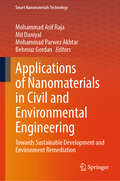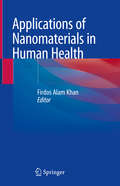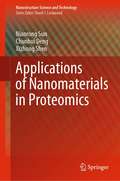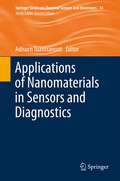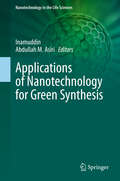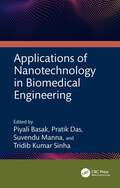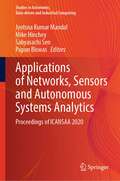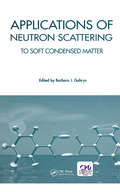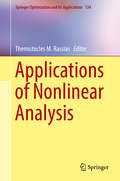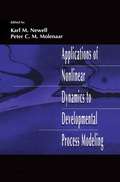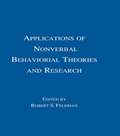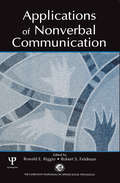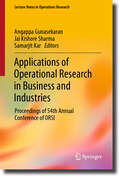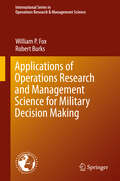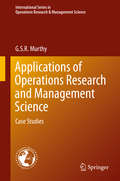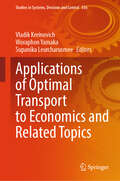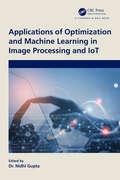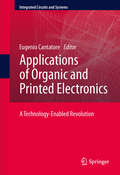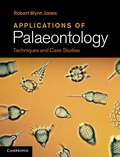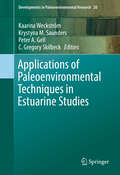- Table View
- List View
Applications of Nanocomposites
by Ahalapitiya H. JayatissaIn this book, different applications of nanomaterials are described based on experiments, validations, and prototype manufacturing. It also covers synthesis, characterization, functionalization and coating of nanomaterials in various application-oriented investigations. The use of nanomaterials in energy storage, catalyst preparation and tribology are a few examples of improving the efficiency of future technologies. In addition, this book has also contributed to the nanomanufacturing of composites for automobile industries, glass industries, textiles and flexible electronics. This book provides knowledge on multiple related fields in applying nanomaterials, emphasizing the most updated literature, understanding applications, and consists of examples and illustrations so that readers can absorb the content rapidly.
Applications of Nanomaterials for Energy Storage Devices
by Amit Saxena Bhaskar Bhattacharya Felipe Caballero-BrionesElectrochemical energy storage devices are the prime interest of researchers and students. This book provides a comprehensive introduction to nanomaterials and their potential applications specifically for electrochemical devices (rechargeable batteries, supercapacitors and so forth) in a coherent and simple manner. It covers fundamental concepts of nanomaterials, chemical and physical methods of synthesis, properties, characterization methods, and related applications. Features: Introduces the evolution of nanoparticles in electrochemical energy storage devices. Provides the detailed information on step-by-step synthesis of nanoparticles. Discusses different characterization methods (structural, electrical, optical, and thermal). Includes the use of nanoparticles in various electrochemical devices. Aims to bridge the gap between the material synthesis and the real application. This book aims at Senior Undergraduate/Graduate students in Material Chemistry, Electrochemistry and Chemical Engineering, and Energy Storage.
Applications of Nanomaterials in Civil and Environmental Engineering: Towards Sustainable Development and Environment Remediation (Smart Nanomaterials Technology)
by Mohammad Asif Raja Md Daniyal Mohammad Parwez Akhtar Behrouz GordanThis book explores the transformative use of nanomaterials in civil engineering, emphasizing sustainability and innovation in addressing enduring challenges. It covers the enhancement of construction materials, including cementitious composites, coatings, and structural components with nanomaterials to improve corrosion resistance, mechanical properties, and cement performance. The integration of nanotechnology with Industry 4.0 and digital twins is also discussed, promoting smarter engineering practices. Additionally, it details the applications of nanomaterials in pavement construction and soil property enhancement for seismic resilience. It addresses soil stabilization, slope stability, ground improvement, and scour protection for waterfront infrastructure. Furthermore, it delves into environmental engineering applications such as advanced wastewater treatment, soil remediation, and air quality improvement through nanotechnology. This book features seventeen chapters by leading experts, offering research insights and practical guidance for sustainable infrastructure and environmental solutions.
Applications of Nanomaterials in Human Health
by Firdos Alam KhanThis book reviews the various applications of nanotechnology in human health. The introductory chapters focus on the classifications, types, synthesis, and characterization of various types of nanomaterials, while subsequent chapters highlight current applications of nanomaterials in the diagnosis and treatment of microbial and viral infections, and also in stem cell biology and regenerative medicine. Further, the book explores the potential role of nanomaterials in connection with neuronal differentiation, neuronal protection, and neurological diseases. It demonstrates the use of nanotechnology to diagnose and treat genetic disorders, as well as endocrine and metabolic syndrome diseases. It also discusses the ethics and the negative impacts of nanomaterials on human health. Lastly, it examines the intellectual property aspects and government regulations associated with the research, design, and commercialization of nanotechnology-based products. Given its scope, it offers a valuable resource for all researchers and professionals working with nanotechnology-based applications in human health.
Applications of Nanomaterials in Proteomics (Nanostructure Science and Technology)
by Nianrong Sun Chunhui Deng Xizhong ShenThis book provides a comprehensive and systematic overview of the latest advances in nanomaterials for proteomics, both theoretical and practical. Consisting of seven chapters, it first covers the synthesis methods, characterization, principles, and performance of functional nanomaterials in various branches of proteomics in detail. This is followed by the applications of nanomaterials for the separation and analysis of various proteins and peptides. Given its scope, the book appeals to a broad readership, including those active in proteomics and materials science; it can also serve as a reference book for students majoring in proteomics analysis.
Applications of Nanomaterials in Sensors and Diagnostics (Springer Series on Chemical Sensors and Biosensors #14)
by Adisorn TuantranontRecent progress in the synthesis of nanomaterials and our fundamental understanding of their properties has led to significant advances in nanomaterial-based gas, chemical and biological sensors. Leading experts around the world highlight the latest findings on a wide range of nanomaterials including nanoparticles, quantum dots, carbon nanotubes, molecularly imprinted nanostructures or plastibodies, nanometals, DNA-based structures, smart nanomaterials, nanoprobes, magnetic nanomaterials, organic molecules like phthalocyanines and porphyrins, and the most amazing novel nanomaterial, called graphene. Various sensing techniques such as nanoscaled electrochemical detection, functional nanomaterial-amplified optical assays, colorimetry, fluorescence and electrochemiluminescence, as well as biomedical diagnosis applications, e.g. for cancer and bone disease, are thoroughly reviewed and explained in detail. This volume will provide an invaluable source of information for scientists working in the field of nanomaterial-based technology as well as for advanced students in analytical chemistry, biochemistry, electrochemistry, material science, micro- and nanotechnology.
Applications of Nanotechnology for Green Synthesis (Nanotechnology in the Life Sciences)
by Inamuddin Abdullah M. AsiriTraditional methods in synthetic chemistry produce chemical waste and byproducts, yield smaller desired products, and generate toxic chemical substances, but the past two centuries have seen consistent, greener improvements in organic synthesis and transformations. These improvements have contributed to substance handling efficiency by using green-engineered forerunners like sustainable techniques, green processes, eco-friendly catalysis, and have minimized energy consumption, reduced potential waste, improved desired product yields, and avoided toxic organic precursors or solvents in organic synthesis. Green synthesis has the potential to have a major ecological and monetary impact on modern pharmaceutical R&D and organic chemistry fields. This book presents a broad scope of green techniques for medicinal, analytical, environmental, and organic chemistry applications. It presents an accessible overview of new innovations in the field, dissecting the highlights and green chemistry attributes of approaches to green synthesis, and provides cases to exhibit applications to pharmaceutical and organic chemistry. Although daily chemical processes are a major part of the sustainable development of pharmaceuticals and industrial products, the resulting environmental pollution of these processes is of worldwide concern. This edition discusses green chemistry techniques and sustainable processes involved in synthetic organic chemistry, natural products, drug syntheses, as well various useful industrial applications.
Applications of Nanotechnology in Biomedical Engineering
by Suvendu Manna Piyali Basak Pratik Das Tridib Kumar SinhaThis book presents recent advancements in nanotechnology-based innovations in the biomedical sciences and engineering fields, including nanoimaging, nano-delivery of drugs and genes, antimicrobial and antiviral coatings, nano-neutraceuticals, and nano-cosmetics. It covers a wide range of topics, which include nanosensors, nano-based coatings, and wound healing, as well as scope for new research and development. It is a guide to the state-of-the-art nanotechnological advancements in medical image processing and disease detection. Features are as follows: Covers industry-oriented applications of nanomaterials in the field of biomedical engineering Discusses development of nature-inspired nano-engineered nutraceuticals Reviews research on nano-coating to restrict biofilm formation and nosocomial infections Includes different aspects of both medical sciences and health sciences, ranging from medical imaging to cosmetics Explores micro-/nano-SMART devices for biomedical applications This book is aimed at researchers and graduate students in biomedical engineering, nanotechnology, and related areas.
Applications of Nanotechnology in Microbiology
by Ramesh S. Chaughule Anushree S. LokurThis book discusses the applications of nanotechnology in clinical microbiology, food microbiology, and green solutions of nanoparticles using microorganisms for a range of benefits. It describes nanotechnology’s rapid progress in the development of materials used in industry, medicine, drug delivery, and dentistry. The authors further explore how microbiology and nanotechnology separately have proven to be effective for human health solutions keeping an ecological and environmental balance. Domains covered include environmental microbiology, medical microbiology, food microbiology (to control food spoilage), biosynthesis of nanomaterials using microorganisms, water microbiology, nanofluidic devices for isolation and analysis of individual biomolecules such as DNA that can lead to a new detection scheme for cancer, and various fields such as pharmacy, clinical research, agriculture etc. This book will be essential reading to a wide range of scholars and researchers interested in microbiology along with nanotechnology applications for efficient solutions to cancer detection, biosensors, vaccines research, agriculture, wastewater management etc.
Applications of Networks, Sensors and Autonomous Systems Analytics: Proceedings of ICANSAA 2020 (Studies in Autonomic, Data-driven and Industrial Computing)
by Mike Hinchey Papun Biswas Jyotsna Kumar Mandal Sabyasachi SenThis book presents high-quality research papers presented at International Conference on Applications of Networks, Sensors and Autonomous Systems Analytics (ICANSAA 2020), held during December, 11 – 12, 2020, at JIS College of Engineering, Kalyani, West Bengal, India. The major topics covered are cyber-physical systems and sensor networks, data analytics and autonomous systems and MEMS and NEMS with applications in biomedical devices. It includes novel and innovative work from experts, practitioners, scientists, and decision-makers from academia and industry.
Applications of Neutron Scattering to Soft Condensed Matter
by Barbara J. GabrysNeutrons, which are a penetrating yet non destructive probe, are ideally suited to studying the structure, organisation and motion of molecules responsible for the physical properties of materials under a variety of conditions. Applications are in fields as diverse as colloid and polymer science, earth sciences, pharmaceutics, biology and engineeri
Applications of Nonlinear Analysis: In Honor Of Haim Brezis And Louis Nirenberg (Springer Optimization and Its Applications #134)
by Themistocles M. RassiasNew applications, research, and fundamental theories in nonlinear analysis are presented in this book. Each chapter provides a unique insight into a large domain of research focusing on functional equations, stability theory, approximation theory, inequalities, nonlinear functional analysis, and calculus of variations with applications to optimization theory. Topics include: Fixed point theoryFixed-circle theoryCoupled fixed pointsNonlinear duality in Banach spacesJensen's integral inequality and applicationsNonlinear differential equationsNonlinear integro-differential equationsQuasiconvexity, Stability of a Cauchy-Jensen additive mappingGeneralizations of metric spacesHilbert-type integral inequality, SolitonsQuadratic functional equations in fuzzy Banach spacesAsymptotic orbits in Hill’sproblemTime-domain electromagneticsInertial Mann algorithmsMathematical modellingRoboticsGraduate students and researchers will find this book helpful in comprehending current applications and developments in mathematical analysis. Research scientists and engineers studying essential modern methods and techniques to solve a variety of problems will find this book a valuable source filled with examples that illustrate concepts.
Applications of Nonlinear Dynamics To Developmental Process Modeling
by Peter C. M. Molenaar Karl M. NewellThere has been an increasing interest in the application of dynamical systems to the study of development over the last decade. The explosion of the dynamical systems framework in the physical and biological sciences has opened the door to a new Zeitgeist for studying development. This appeal to dynamical systems by developmentalists is natural given the intuitive links between the established fundamental problems of development and the conceptual and operational scope of nonlinear dynamical systems. This promise of a new approach and framework within which to study development has led to some progress in recent years but also a growing appreciation of the difficulty of both fully examining the new metaphor and realizing its potential. Divided into 4 parts, this book is a result of a recent conference on dynamical systems and development held at Pennsylvania State University. The first 3 parts focus on the content domains of development that have given most theoretical and empirical attention to the potential applications of dynamical systems--physical growth and movement, cognition, and communication. These parts show that a range of nonlinear models have been applied to a host of developmental phenomena. Part 4 highlights two particular methodological issues that hold important implications for the modeling of developmental phenomena with dynamical systems techniques.
Applications of Nonverbal Behavioral Theories and Research
by Robert S. FeldmanThis book is intended to accomplish several goals. First, it is designed to provide a broad overview of the major areas of application of theory and research relating to nonverbal behavior. Second, individual chapters emphasize how the applications have been drawn from underlying theories and empirical bases, thereby making the link between theory, research, and applications apparent. Finally, the volume links individual chapter contributions, demonstrating how theoretical progress over the last few decades has led to important applied advances. The contributors to this book consider a wide variety of settings and topics. Their common thread, however, is a shared conviction that an understanding of nonverbal behavior can bring about an improvement in the human condition. Each of the authors has made suggestions regarding future directions for both research and practice -- and their ideas offer real promise.
Applications of Nonverbal Communication (Claremont Symposium on Applied Social Psychology Series)
by Robert S. Feldman Ronald E. RiggioThe goal of this edited volume is to provide a much needed bridge between the research on nonverbal communication and the application of those findings. The book features contributions from some of the leading researchers in the field. These distinguished scholars apply their understanding of nonverbal communication processes to a variety of settings including hospitals and clinics, courtrooms and police stations, the workplace and government, the classroom, and everyday life. It explores nonverbal communication in public settings, in intimate relationships, and across cultures and general lessons such as the importance of context, individual differences, and how expectations affect interpretation.Applications of Nonverbal Communication appeals to a diverse group of practitioners, researchers, and students from a variety of disciplines including psychology, health care, law enforcement, political science, sociology, communication, business and management. It may also serve as a supplement in upper level courses on nonverbal communication.
Applications of Numerical Methods in Molecular Spectroscopy
by Peter Pelikan Michal Ceppan Marek LiskaApplications of Numerical Methods in Molecular Spectroscopy provides a mathematical background, theoretical perspective, and review of spectral data processing methods. The book discusses methods of complex spectral profile separation into bands, factor analysis methods, methods of quantitative analysis in molecular spectroscopy and reflectance spectroscopy, and new data processing methods. Mathematical methods in special areas of molecular spectroscopy, such as color science, electron spin resonance, and nuclear magnetic resonance spectroscopies are also covered. The book will benefit researchers and postgraduate students in fields of chemistry, physics, and biology.
Applications of Operational Research in Business and Industries: Proceedings of 54th Annual Conference of ORSI (Lecture Notes in Operations Research)
by Samarjit Kar Angappa Gunasekaran Jai Kishore SharmaEffective decision-making while trading off the constraints and conflicting multiple objectives under rapid technological developments, massive generation of data, and extreme volatility is of paramount importance to organizations to win over the time-based competition today. While agility is a crucial issue, the firms have been increasingly relying on evidence-based decision-making through intelligent decision support systems driven by computational intelligence and automation to achieve a competitive advantage. The decisions are no longer confined to a specific functional area. Instead, business organizations today find actionable insight for formulating future courses of action by integrating multiple objectives and perspectives. Therefore, multi-objective decision-making plays a critical role in businesses and industries. In this regard, the importance of Operations Research (OR) models and their applications enables the firms to derive optimum solutions subject to various constraints and/or objectives while considering multiple functional areas of the organizations together. Hence, researchers and practitioners have extensively applied OR models to solve various organizational issues related to manufacturing, service, supply chain and logistics management, human resource management, finance, and market analysis, among others. Further, OR models driven by AI have been enabled to provide intelligent decision-support frameworks for achieving sustainable development goals.The present issue provides a unique platform to showcase the contributions of the leading international experts on production systems and business from academia, industry, and government to discuss the issues in intelligent manufacturing, operations management, financial management, supply chain management, and Industry 4.0 in the Artificial Intelligence era. Some of the general (but not specific) scopes of this proceeding entail OR models such as Optimization and Control, Combinatorial Optimization, Queuing Theory, Resource Allocation Models, Linear and Nonlinear Programming Models, Multi-objective and multi-attribute Decision Models, Statistical Quality Control along with AI, Bayesian Data Analysis, Machine Learning and Econometrics and their applications vis-à-vis AI & Data-driven Production Management, Marketing and Retail Management, Financial Management, Human Resource Management, Operations Management, Smart Manufacturing & Industry 4.0, Supply Chain and Logistics Management, Digital Supply Network, Healthcare Administration, Inventory Management, consumer behavior, security analysis, and portfolio management and sustainability. The present issue shall be of interest to the faculty members, students, and scholars of various engineering and social science institutions and universities, along with the practitioners and policymakers of different industries and organizations.
Applications of Operations Research and Management Science for Military Decision Making (International Series in Operations Research & Management Science #283)
by William P. Fox Robert BurksBased on many years of applied research, modeling and educating future decision makers, the authors have selected the critical set of mathematical modeling skills for decision analysis to include in this book. The book focuses on the model formulation and modeling building skills, as well as the technology to support decision analysis. The authors cover many of the main techniques that have been incorporated into their three-course sequence in mathematical modeling for decision making in the Department of Defense Analysis at the Naval Postgraduate School.The primary objective of this book is illustrative in nature. It begins with an introduction to mathematical modeling and a process for formally thinking about difficult problems, illustrating many scenarios and illustrative examples. The book incorporates the necessary mathematical foundations for solving these problems with military applications and related military processes to reinforce the applied nature of the mathematical modeling process.
Applications of Operations Research and Management Science: Case Studies (International Series in Operations Research & Management Science #229)
by G. S. R. MurthyThis book includes case studies that examine the application of operations research to improve or increase efficiency in industry and operational activities. This collection of "living case studies" is all based on the author's 30-year career of consulting and advisory work. These true-to life industrial applications illustrate the research and development of solutions, as well as potential implementation and integration problems that may occur when adopting these methods into a business. Among the topics covered in the chapters include optimization in circuit board manufacturing, Decision Support System (DSS) for plant loading and dispatch planning, as well as development of important test procedures for tyre and pharma industry with shelf life constraints. In particular, the study on deckle optimization should be of great help to managers in paper industry and consultants for development of deckle optimization software. The application of operations research throughout the industry makes it an ideal guide for industrial executives, professionals and practitioners responsible for quality and productivity improvement.
Applications of Optimal Transport to Economics and Related Topics (Studies in Systems, Decision and Control #556)
by Vladik Kreinovich Woraphon Yamaka Supanika LeurcharusmeeOften, when a new successful data processing techniques appears in one of the application areas, it then proves to be useful in many other areas. This was the case of optimal transportation techniques: these techniques were first developed for transportation problems, but now they have been shown to be successful in many statistical applications, including applications to economics. These techniques are the main focus of this book, but this book also contain papers that use other techniques, ranging from more traditional statistical approaches to more recent ones such as stochastic frontier methods, multivariable quantiles, random forest, and deep learning. Applications include all aspects of economics, from production (including agricultural) to trade (including international) and finances, with relation to issues of crime (including computer crime and cyberbullying), demographics, economic freedom, environment, health, and tourism. We hope that this volume will: help practitioners to become better knowledgeable of the state-of-the-art econometric techniques, especially optimal transport techniques, and help researchers to further develop these important research directions. We want to thank all the authors for their contributions and all anonymous referees for their thorough analysis and helpful comments. The publication of this volume was partly supported by the Faculty of Economics of the Chiang Mai University, Thailand. Our thanks to the leadership and staff of the Chiang Mai University for providing crucial support. Our special thanks to Prof. Hung T. Nguyen for his valuable advice and constant support.
Applications of Optimization and Machine Learning in Image Processing and IoT
by Dr Nidhi GuptaThis book presents state-of-the-art optimization algorithms followed by Internet of Things (IoT) fundamentals. The applications of machine learning and IoT are explored, with topics including optimization, algorithms and machine learning in image processing and IoT. Applications of Optimization and Machine Learning in Image Processing and IoT is a complete reference source, providing the latest research findings and solutions for optimization and machine learning algorithms. The chapters examine and discuss the fields of machine learning, IoT and image processing. KEY FEATURES: • Includes fundamental concepts towards advanced applications in machine learning and IoT. • Discusses potential and challenges of machine learning for IoT and optimization • Reviews recent advancements in diverse researches on computer vision, networking and optimization field. • Presents latest technologies such as machine learning in image processing and IoT This book has been written for readers in academia, engineering, IT specialists, researchers, industrial professionals and students, and is a great reference for those just starting out in the field as well as those at an advanced level.
Applications of Organic and Printed Electronics: A Technology-Enabled Revolution (Integrated Circuits and Systems)
by Eugenio CantatoreOrganic and printed electronics can enable a revolution in the applications of electronics and this book offers readers an overview of the state-of-the-art in this rapidly evolving domain. The potentially low cost, compatibility with flexible substrates and the wealth of devices that characterize organic and printed electronics will make possible applications that go far beyond the well-known displays made with large-area silicon electronics. Since organic electronics are still in their early stage, undergoing transition from lab-scale and prototype activities to production, this book serves as a valuable snapshot of the current landscape of the different devices enabled by this technology, reviewing all applications that are developing and those can be foreseen.
Applications of Palaeontology
by Robert Wynn JonesPalaeontology, the scientific study of fossils, has developed from a descriptive science to an analytical science used to interpret relationships between earth and life history. This book provides a comprehensive and thematic treatment of applied palaeontology, covering the use of fossils in the ordering of rocks in time and in space, in biostratigraphy, palaeobiology and sequence stratigraphy. Robert Wynn Jones presents a practical workflow for applied palaeontology, including sample acquisition, preparation and analysis, and interpretation and integration. He then presents numerous case studies that demonstrate the applicability and value of the subject to areas such as petroleum, mineral and coal exploration and exploitation, engineering geology and environmental science. Specialist applications outside of the geosciences (including archaeology, forensic science, medical palynology, entomopalynology and melissopalynology) are also addressed. Abundantly illustrated and referenced, Applications of Palaeontology provides a user-friendly reference for academic researchers and professionals across a range of disciplines and industry settings.
Applications of Palaeontology: Techniques and Case Studies
by Robert Wynn JonesPalaeontology, the scientific study of fossils, has developed from a descriptive science to an analytical science used to interpret relationships between earth and life history. This book provides a comprehensive and thematic treatment of applied palaeontology, covering the use of fossils in the ordering of rocks in time and in space, in biostratigraphy, palaeobiology and sequence stratigraphy. Robert Wynn Jones presents a practical workflow for applied palaeontology, including sample acquisition, preparation and analysis, and interpretation and integration. He then presents numerous case studies that demonstrate the applicability and value of the subject to areas such as petroleum, mineral and coal exploration and exploitation, engineering geology and environmental science. Specialist applications outside of the geosciences (including archaeology, forensic science, medical palynology, entomopalynology and melissopalynology) are also addressed. Abundantly illustrated and referenced, Applications of Palaeontology provides a user-friendly reference for academic researchers and professionals across a range of disciplines and industry settings.
Applications of Paleoenvironmental Techniques in Estuarine Studies (Developments in Paleoenvironmental Research #Volume 20)
by Kaarina Weckström Krystyna M. Saunders Peter A. Gell C. Gregory SkilbeckThe aim of this edited volume is to introduce the scientific community to paleoenvironmental studies of estuaries, to highlight the types of information that can be obtained from such studies, and to promote the use of paleoenvironmental studies in estuarine management. <P><P> Readers will learn about the the application of different paleoecological approaches used in estuaries that develop our understanding of their response to natural and human influences. Particular attention is given to the essential steps required for undertaking a paleoecological study, in particular with regard to site selection, core extraction and chronological techniques, followed by the range of indicators that can be used. A series of case studies are discussed in the book to demonstrate how paleoecological studies can be used to address key questions, and to sustainably manage these important coastal environments in the future. This book will appeal to professional scientists interested in estuarine studies and/or paleoenvironmental research, as well as estuarine managers who are interested in the incorporation of paleoenvironmental research into their management programs.


